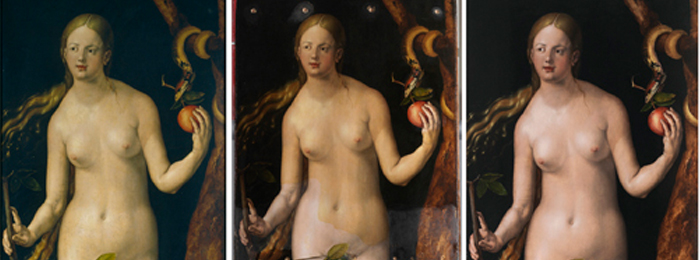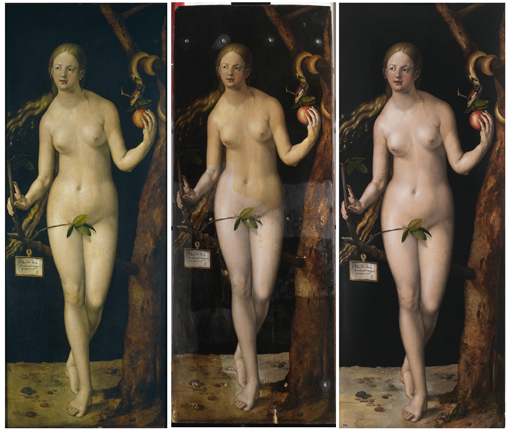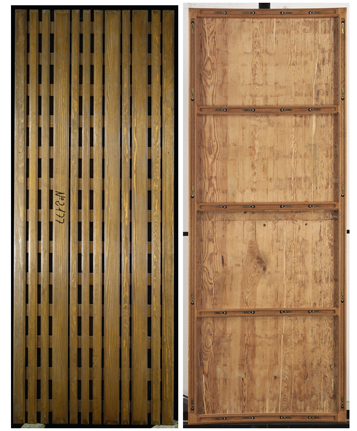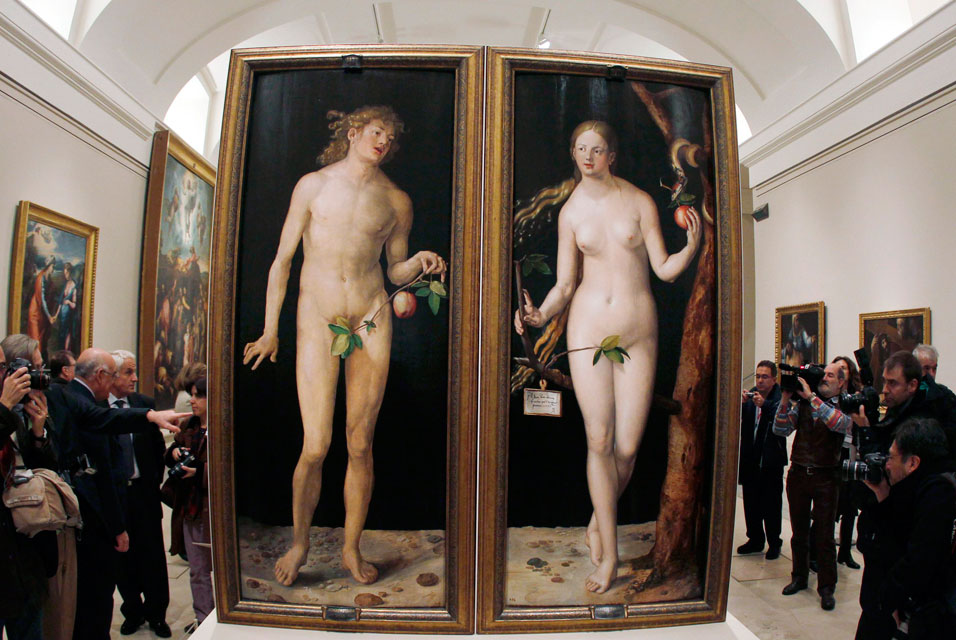The Restoration of Adam and Eve by Dürer

The Restoration of Adam and Eve by Dürer
Documentation exists on the restorations undertaken on the paintings since the 18th century when they were in the Spanish royal collection. Having entered the Prado in 1827, they were restored in the mid-19th century and it is recorded that further work was undertaken on the Adam in the 20th century, when a cradle was attached to the back.
The accumulation of these interventions ultimately resulted in a harsh, flat image that lacked the original enamelled effect achieved by the artist. Thick layers of dirt, oxidised varnishes and areas of repainting that had darkened over time covered the paint surfaces, concealing Dürer’s brushstrokes and original colouring.

Adam prior to restoration, during and after. These three images show how damage to the support had directly and negatively affected the paint layer, resulting in losses to the preparation and color. The final images show how these were fully restored.
These old restorations also affected the panels and resulted in numerous vertical cracks, particularly in the Adam. The depth of that panel was reduced in order to attach a rigid structure to the back, after which the original wood could not move. The Eve panel had three new cross-bars nailed to it from the front in order to eliminate its natural curvature. The inevitable movement of the wood had resulted in distortions and bulging that in turn created shadows and irregularities on the paint surface and negatively affected Dürer’s forms. All these problems meant that restoration was considered necessary.
In 2004 the Prado organised an international meeting on the project to restore the Adam and Eve. It saw the participation of restorers from various institutions and was intended to establish the best way of approaching a project of this complexity and delicacy. Work on the panels was completed in 2009.
In collaboration with the Metropolitan Museum conservator, George Bisacca and an engineer, research was undertaken to develop a new mechanism based on springs that would give Adam’s panel (one of which had been reduced in thickness and cradled in the past) greater structural resistance. This mechanism can now be used in other similar restorations.

Eve, prior to restoration, during and after. Particularly notable is the flesh tone of the figure, which is due to oxidised varnishes, alongside the delicate, pearly pink coloring of the figure after restoration. Also evident is the contrast with the ground, which is of a more transparent, silvery tone. The holes used to insert cross-bars in the past are also visible. These were inserted through the paint surface, literally splitting the preparatory layer and paint surface.
The old cradle (a wooden grid stuck to the back of the original panel) was removed from the Adam and the numerous cracks that it had produced were closed up. Due to the fragility of that panel it was decided to attach a new, reinforcing structure that would respect the natural curvature of the wood and which was only attached to the original panel at a number of specific points, thus allowing it to move freely. The three, screwed-on cross-bars were removed from the Eve panel while the original surviving cross-bar was restored and laminated in order to adapt it to the curvature of the panel.

Panel of Adam before, during and after restoration. The restoration of the support began with the removal of the wooden cradle that had been stuck on to the panel during a previous restoration and had resulted in numerous cracks and distortions. Having closed up the cracks the panel was given a new type of support. This was attached to the back bearing in mind the natural curvature of the panel on which Dürer painted his work and involved an ingenious solution with various spring mechanisms that guaranteed an appropriate response to the natural dilations, contractions and flexions characteristic of wood.
Having stabilised the support and given the panels smooth, continuous surfaces, work started on the delicate, complex task of restoring the paint surfaces, undertaken by Maite Dávila. Her work involved eliminating the incorrect contrasts and modifications visible in the paintings, as well as revealing the underdrawing, which the artist executed with a brush and a fluid medium. Of great complexity and refinement, this underdrawing was softened by Dürer through the application of fine glazes of flesh tones that served to emphasise the differences between the male and female nudes.
Restoration details by:
- Pilar Silva Maroto, Head of the Department of Flemish Painting (1400-1600) and of Spanish Painting (1100-1500).
- Maite Dávila, paintings restorer.
- José de la Fuente, supports restorer.
Source: museodelprado.es
courtesy Museo del Prado
© All Rights Reserved where not otherwise stated.
![]() To Your Creative Success,
To Your Creative Success,
Natalie Richy and Vladimir London
Web Art Academy Founders



This Post Has 0 Comments